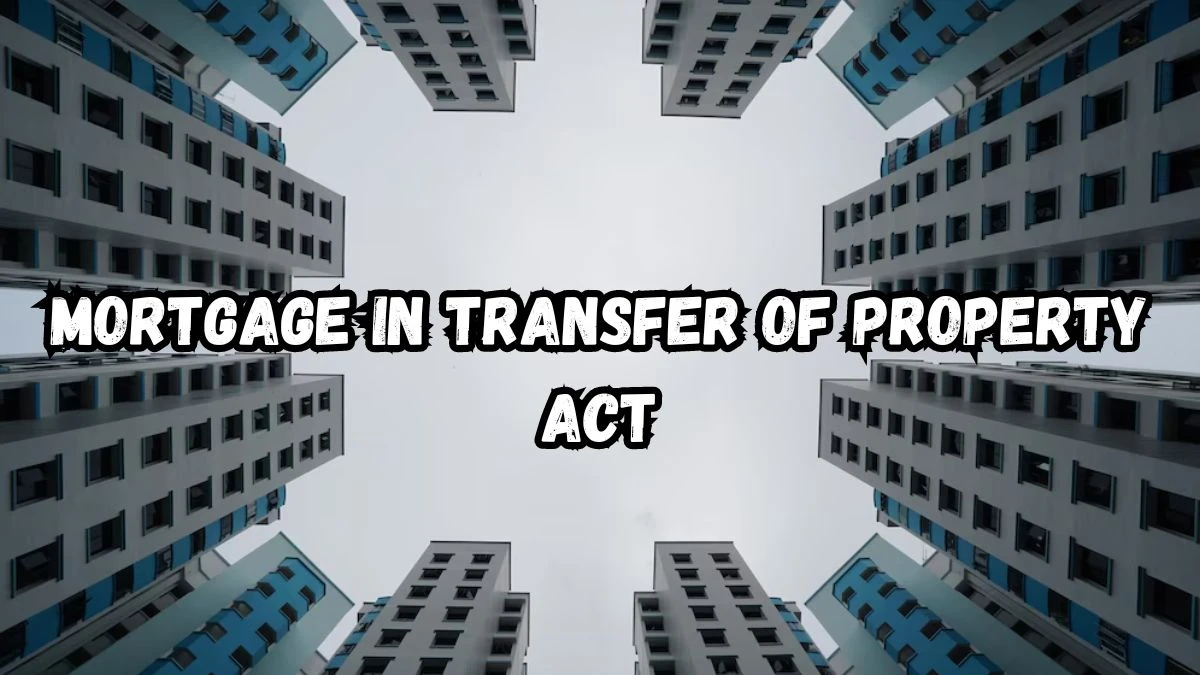
Mortgage in Transfer of Property Act, Kinds, Stages and More
A mortgage under the Transfer of Property Act, of 1882, is a legal agreement where a borrower uses the property as collateral to secure a loan from a lender. The act defines different types of mortgages and outlines the rights and responsibilities of both parties.
by Ruksana
Updated Aug 12, 2024
On This Page
Mortgage in Transfer of Property Act
A mortgage under the Transfer of Property Act, of 1882, is a legal agreement where the borrower gives a lender a right to an interest in an immovable property, like a house or land, as security for a loan. This means if the borrower fails to repay the loan, the lender can take legal steps to sell the property and recover the money lent. The Act outlines clear rules to protect both the borrower and the lender.
It explains how a mortgage should be created, the rights of the borrower to get the property back after paying the loan (called redemption), and the lender’s right to sell the property if the borrower doesn’t pay it back.
The Act specifies several types of mortgages, each with different rules and implications. It ensures that the agreement is transparent and fair, helping prevent disputes between the parties. By requiring certain mortgages to be registered, it also helps to make the transaction legally enforceable.
The Transfer of Property Act provides a structured and secure way for people to borrow money using their property as collateral while protecting their rights and ensuring the lender can recover their loan if needed.
Kinds of Mortgage in Transfer of Property Act
These are the Kinds of Mortgage in Transfer of Property Act:
Simple Mortgage:
- Property is security for the loan.
- No transfer of ownership.
- The borrower repays, and the property is free of the mortgage.
Mortgage by Conditional Sale:
- The property is sold conditionally.
- The sale becomes void if the loan is repaid.
- Ownership transfers only if the borrower defaults.
Usufructuary Mortgage:
- The lender takes possession of the property.
- The lender earns income from the property until the loan is repaid.
- Borrower retains ownership.
English Mortgage:
- Ownership and possession are transferred to the lender.
- The lender reconveys the property upon full repayment.
Mortgage by Deposit of Title Deeds:
- The borrower deposits property documents with the lender.
- Also known as an equitable mortgage.
- Common in urban areas.
Anomalous Mortgage:
- Does not fit into the other categories.
- It can be a combination of different mortgage types.
How to Register a Mortgage in Transfer of Property Act?
These are the Steps to Register a Mortgage:
Prepare Necessary Documents:
- Mortgage Deed: A legal document outlining the terms of the mortgage.
- Property Documents: Proof of ownership of the property being mortgaged.
- Identity Proofs: Documents like a passport, voter ID, or driver's license for the borrower.
Visit the Local Registrar's Office:
- Go to the registrar's office in the area where the property is located.
Submit the Documents:
- Present all the required documents to the registrar.
Pay the Registration Fees:
- Pay the necessary fees for registering the mortgage.
Verification Process:
- The registrar will verify the documents and ensure everything is in order.
Receive Registration Certificate:
- Once verified, the registrar will issue a registration certificate, giving legal recognition to the mortgage.
Keep a Copy of the Registered Deed:
- Ensure you keep a copy of the registered mortgage deed for your records.
Stages of Mortgage
1. Pre-Approval Stage
Financial Assessment:
- Evaluate your financial situation and credit score.
- Determine the loan amount you can afford.
Get Pre-Approved:
- Contact lenders and submit necessary documents for pre-approval.
- Pre-approval helps you understand your borrowing capacity.
2. House Shopping Stage
Search for Properties:
- Look for properties within your budget.
- Consider location, size, and other preferences.
Make an Offer:
- Once you find a suitable property, make an offer to the seller.
3. Mortgage Application Stage
Submit Application:
- Complete the mortgage application form with the chosen lender.
- Provide all required documents, such as income proof and property details.
Pay Processing Fees:
- Pay any fees required to process the application.
4. Loan Processing Stage
Document Verification:
- The lender verifies all the submitted documents.
Property Appraisal:
- An appraisal is conducted to determine the property's value.
5. Underwriting Stage
Risk Assessment:
- The lender assesses the risk associated with the loan.
Approval Decision:
- Based on the assessment, the lender approves or denies the loan.
6. Closing Stage
Sign Loan Documents:
- Once approved, sign all necessary loan documents.
Pay Closing Costs:
- Pay any closing costs associated with the mortgage.
Receive Funds:
- The loan amount is disbursed, and the property transaction is completed.
Begin Repayment:
- Start making monthly payments as per the loan agreement.
Mortgage in Transfer of Property Act
1. What is a mortgage under the Transfer of Property Act?
A mortgage is an agreement where property is used as security for a loan.
2. What types of mortgages are there in the Transfer of Property Act?
The types include simple mortgage, mortgage by conditional sale, and usufructuary mortgage.
3. Who is a mortgagor in a mortgage agreement?
The mortgagor is the borrower who offers the property as security.
4. What happens if a borrower cannot repay the mortgage?
If a borrower defaults, the lender can sell the property to recover the loan.
5. How is a mortgage registered under the Transfer of Property Act?
A mortgage is registered by submitting the deed and necessary documents to the local registrar.




